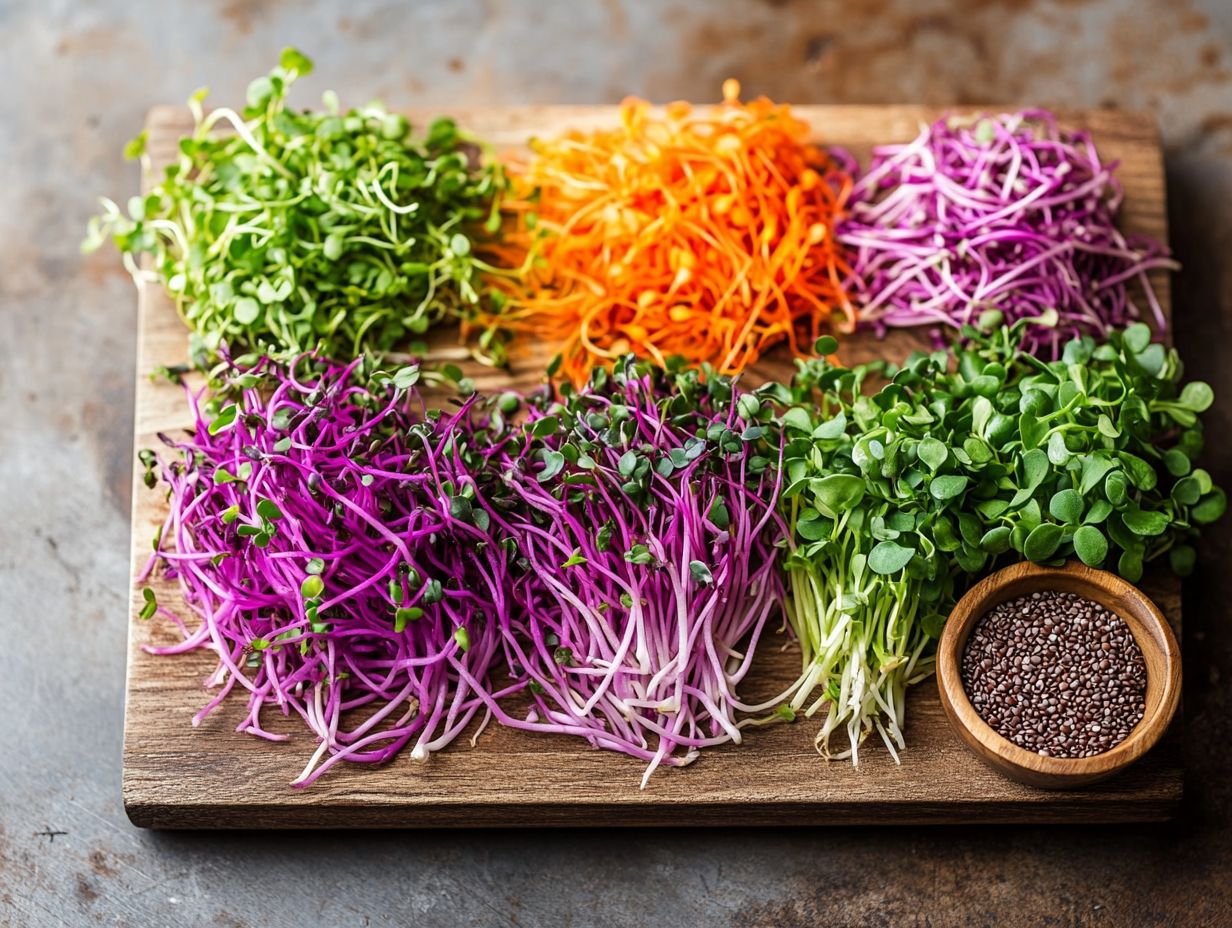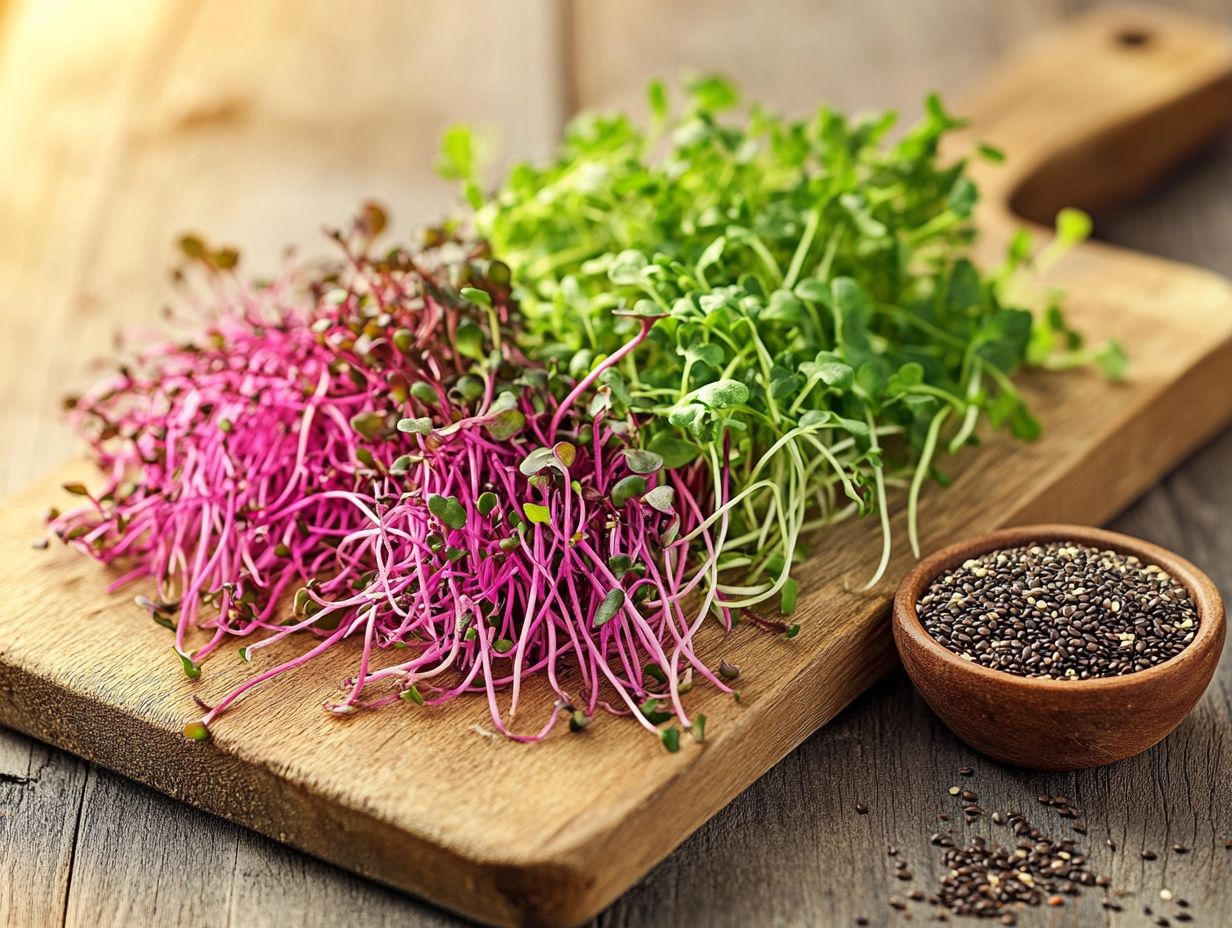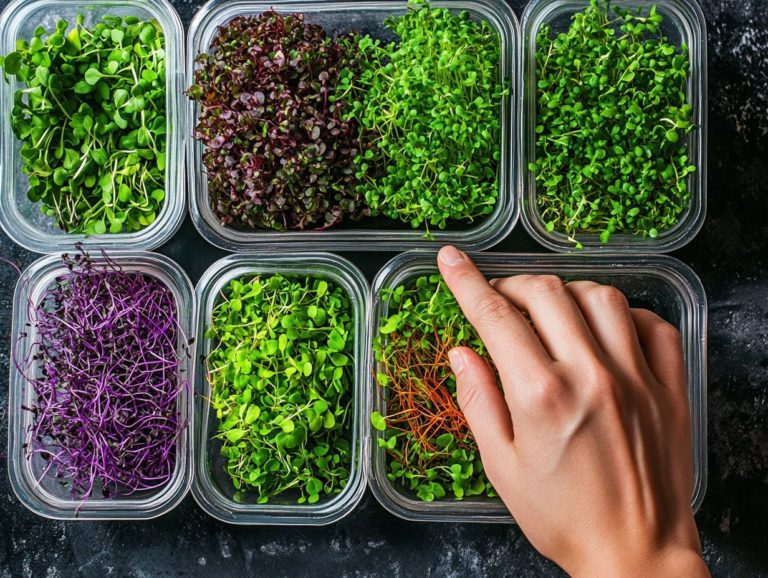The Hidden Health Benefits of Microgreens
Microgreens are small but mighty plants that provide a remarkable nutritional boost, making them a chic addition to your plant-based diet.
This article delves into what microgreens are, exploring their various types and how they stack up against mature greens in terms of nutritional analysis. You ll uncover their impressive health benefits, from enhancing the immune system to supporting heart health and improving digestion.
You ll also find fun ways to incorporate microgreens into your meals with simple recipes and serving suggestions.
Get ready to discover the amazing potential of these vibrant greens!
Contents
Key Takeaways:

- Microgreens pack a powerful nutritional punch, containing up to 40 times more nutrients than mature greens. They are a great addition to any diet.
- These tiny greens may help boost immunity, support heart health, and improve digestion thanks to their high concentrations of vitamins, minerals, and antioxidants.
- From salads to smoothies, there are countless delicious ways to incorporate microgreens into your meals. Give them a try today!
What are Microgreens?
Microgreens, those delightful young plants, are harvested at a tender stage of growth, usually when they stand just 1 to 3 inches tall. They are adored for their vivid colors, bold flavors, and versatility in the kitchen.
Among the popular varieties you might encounter are lettuce microgreens, clover microgreens, broccoli, and fenugreek. These common microgreens have earned their reputation not only for their exquisite taste but also for their impressive nutritional benefits, including nutritional advantages for kids, appealing to both health-conscious individuals and urban gardening aficionados.
Definition and Types
Microgreens are the tender seedlings of vegetables and herbs, harvested just after the first true leaves emerge. They come in an impressive array of types, each showcasing unique flavors and vibrant colors.
Take clover microgreens, for example; they offer a mild, slightly sweet flavor that makes them a versatile addition to salads and sandwiches. Then there are broccoli microgreens, which provide a robust nutritional profile and add a peppery kick that enhances various dishes, particularly stir-fries and grain bowls. Moreover, understanding the role of microgreens in sustainable eating can further highlight their benefits.
Don’t overlook radish microgreens, renowned for their zesty bite, or kale microgreens, which impart a subtle earthiness. Each variety contributes its distinct character to your culinary creations, enhancing both the presentation and flavor on the plate. Incorporating these greens can show you why microgreens are essential for a balanced diet.
Nutritional Value of Microgreens
The nutritional value of microgreens is truly remarkable. They are packed with essential vitamins, minerals, and antioxidants, often boasting higher concentrations of these nutrients than their mature counterparts.
Incorporating microgreens into your diet not only enhances the flavor of your meals but also elevates your nutritional intake, making them a great source of nutrients for your healthy lifestyle.
Comparison to Mature Greens

When you compare microgreens to their mature counterparts, it becomes clear that microgreens serve as a concentrated source of vitamins, minerals, and antioxidants, significantly boosting your health benefits.
These tiny powerhouses, typically harvested just after they develop true leaves, are packed with nutrients. For example, the vitamin K content in microgreens can be up to five times greater than in older greens. You’ll also find higher levels of vitamin C, crucial for immune function, nestled within these delicate greens, promoting better overall health. Incorporating the top 10 microgreens for nutritional boost into your diet can further enhance these benefits.
Additionally, microgreens shine with their richness in vitamin A, essential for both vision and skin health. Comparative tables showcasing nutrient levels clearly indicate that adding microgreens to your diet enhances your nutritional intake, making them a savvy choice for anyone mindful of their health. For more insights, check out why microgreens are superfoods you need.
Health Benefits of Microgreens
Microgreens offer a remarkable range of health benefits. These tiny greens can boost your immune system, aid in disease prevention, and supply essential nutrients.
They may help fight chronic ailments like cancer and heart disease. Embrace microgreens today, especially considering their role in cancer prevention and managing insulin resistance!
Boosting Immunity and Disease Prevention
Microgreens are a treasure trove of antioxidants and essential nutrients. They can significantly bolster your immune system and offer protective benefits against various diseases, including cancer and Type 2 diabetes.
These petite greens, often grown from seeds of vegetables like broccoli, kale, and radishes, can pack up to 40 times more nutrients than their mature counterparts. For instance, broccoli microgreens stand out for their impressive levels of sulforaphane, a compound celebrated for its potential cancer-fighting abilities. To learn more about their benefits, check out unlocking the antioxidant power of microgreens.
Research indicates that antioxidants such as vitamins C and E found in beet and sunflower microgreens can notably reduce harmful effects in the body, which are associated with chronic diseases like heart disease and Type 2 diabetes. Studies published in prestigious journals underscore the robust link between the regular consumption of these nutrient-rich delights and enhanced immune function, as detailed in the science behind microgreens and health.
Supporting Heart Health
Don’t miss out on the health benefits these tiny greens can offer! Incorporating microgreens into your balanced diet can significantly support your heart health.
These tiny greens are packed with vitamins, minerals, and nutrients, which help combat heart disease and improve insulin resistance.
Rich in potassium, microgreens play a crucial role in maintaining healthy blood pressure levels, effectively reducing your risk of hypertension. They also often contain omega-3 fatty acids, renowned for their anti-inflammatory properties that enhance overall cardiovascular function, making them an important part of healthy eating.
Recent studies show a direct link between these nutrients and improved heart health markers. This suggests that by regularly including the top microgreen varieties for health enthusiasts in your meals, you may experience better lipid profiles and enhanced arterial function.
Improving Digestion and Gut Health

Microgreens are your allies in achieving improved digestion and gut health. They are packed with essential nutrients like polyphenols that support the digestive process and nurture a healthy gut microbiome.
These tiny powerhouses are brimming with fiber, a crucial component for regulating bowel movements and keeping constipation at bay. Their high fiber content also plays a role in managing blood sugar levels.
Some microgreens even offer digestive enzymes that help break down food more effectively, enhancing nutrient absorption. By incorporating these vibrant greens into your diet, you can promote greater stability in your gut microbiome.
This leads to enhanced overall health. The synergy between the nutritional benefits of microgreens and a balanced diet is essential for nurturing the diverse array of beneficial bacteria that support optimal digestive function.
How to Incorporate Microgreens into Your Diet
Incorporating microgreens into your diet is not just effortless; it elevates the flavor profile of an array of dishes.
You can seamlessly add them to salads, sandwiches, and s smoothies, or use them as a sophisticated garnish to enhance the culinary uses and presentation of your meals.
Start making small changes today for big health benefits!
Recipes and Serving Suggestions
You ll discover a treasure trove of recipes and serving suggestions for microgreens, ranging from straightforward salads to gourmet creations that highlight their flavor and nutritional benefits. These vibrant greens do more than just brighten up your plate; they have unique flavors that can elevate any dish. This enhances your cooking experience.
For example, pairing radish microgreens with avocado toast adds a delightful crunch and a zesty kick. Meanwhile, basil microgreens elevate pasta dishes with their aromatic depth. Integrating a mix of microgreens into your smoothies or juices offers a healthy addition to your meal planning without sacrificing flavor. Discover more about the impact of microgreens on overall wellbeing to enhance your culinary creations.
Whether you re sprinkling them over roasted vegetables or mixing them into a fresh salsa, their culinary versatility makes them an ideal ingredient for enhancing flavor.
Frequently Asked Questions
What are microgreens?

Microgreens are young vegetable greens that are harvested after the first true leaves have developed, usually within 7-14 days of germination. They are smaller than baby greens and larger than sprouts, and are packed with nutrients and flavor.
Microgreens are known to have high concentrations of vitamins, minerals, and antioxidants. Antioxidants are substances that help protect your cells from damage, while polyphenols are compounds that may improve heart health. They also contain enzymes that aid in digestion and have anti-inflammatory properties.
Some studies have shown that microgreens can even lower the risk of chronic diseases like heart disease and cancer.
How can microgreens be incorporated into my diet?
Add microgreens to your salads, sandwiches, and smoothies for a burst of flavor! They add a burst of vitamins and nutrition to any meal. You can also mix different types of microgreens together to create a more diverse nutrient profile, enhancing their health benefits.
Are there different types of microgreens?
Yes, there are a variety of microgreens available, including arugula, broccoli, kale, radish, lettuce microgreens, and sunflower. Each type has its own unique flavor and nutrient profile, making them versatile ingredients. It’s best to experiment and find your favorites!
Do microgreens require special care when growing?
Microgreens can be grown at home with minimal equipment and care. They only need a shallow container, good potting soil, and water. They can be grown in a sunny window or under grow lights. It’s important to keep the soil moist but not waterlogged to prevent mold growth, as this can negatively impact the growth conditions of your microgreens.
Can anyone eat microgreens?
Yes, microgreens are suitable for people of all ages and dietary restrictions. They are a great way to add more nutrients, such as antioxidants and polyphenols, to your diet. Their small size makes them easy to chew and digest.
However, if you have any allergies or medical conditions, including insulin resistance or a high-fat diet, it’s always best to consult with a doctor before adding new foods to your diet.






